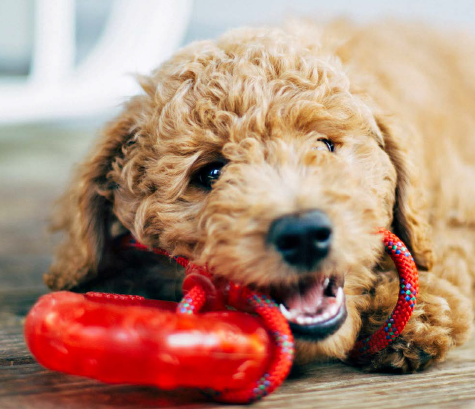Chew This, Not that: Brian Collins talks with WebMD about how to redirect chewing
 Chew This, Not That
Chew This, Not That
Chewing is a canine instinct—as natural as barking and tail-wagging. You can’t put a stop to it, but you can redirect it.
BY Sonya Collins
REVIEWED BY Will Draper, DVM
WebMD Medical Reviewer
Has this ever happened to you? You come home from work to find your puppy staring up at you—with those eyes—and the strap of your favorite sandal is hanging out of his mouth or clumps of pillow stuffing are on the floor behind him.
Wait. Don’t yell.
Some chewing is part of being a dog, and some is a sign of a bigger problem. How you should handle it depends on the cause.
“Puppies chew. It’s how they explore, just like human babies,” says Brian  Collins, DVM, a veterinarian at Cornell University Companion Animal Hospital. Older dogs do it, too. “They may do it just to pass the time,” he says. Dogs also gnaw to keep their teeth clean and their jaws strong.
Collins, DVM, a veterinarian at Cornell University Companion Animal Hospital. Older dogs do it, too. “They may do it just to pass the time,” he says. Dogs also gnaw to keep their teeth clean and their jaws strong.
But something may be eating at your pup. Beware of other signs of stress besides just chewing. “Digging, howling, and barking are clinical signs of distress,” Collins says. “Ripping up lots of things, pulling things off tables, breaking screen doors—these things indicate the dog just isn’t happy.” He could be anxious or bored, for example.
Normal or not, eating your shoes or un-stuffing your throw pillow is unacceptable. Gnawing things that he shouldn’t isn’t good for him either. When canines get their jaws around things that aren’t meant for them, they can break their teeth or swallow something that can get stuck in their gastrointestinal tract. Both puppies and adult dogs can learn from obedience training, whether it’s through a private trainer, classes at the local pet supply store, or techniques you pick up from a book or video. This will help when you begin to teach him what he can and can’t sink his teeth into.
While you teach your pup what’s okay to chew, keep forbidden items out of reach and toys in plain sight. “It’s not always convenient, but it’s for a relatively short time,” Collins says. If you don’t want him to eat up your clothes, make all clothes off limits. Don’t give him an old T-shirt just because you don’t want it anymore. He can’t tell the difference.
Don’t punish. Just take the object away, replace it with a toy, and reward the good behavior. “Positive reinforcement is the most effective and humane approach to addressing behavior issues,” Collins says.
Provide enough toys to entertain your pooch, but not so many that it’s hard for him to learn what’s a toy and what isn’t. Leave out about three to five at a time. Switch them out sometimes, so your dog doesn’t get bored and go back to work on the coffee table.
Make sure your dog gets plenty of exercise and playtime, so he doesn’t have as much energy for chewing. “If they have lots of pent-up energy because they’re not exercising, it can certainly make any behavior problem worse,” Collins says.
If you suspect the chewing is a sign of distress, it could be separation anxiety. “For whatever reason, early on in life, some dogs don’t get accustomed to being alone,” Collins says. This type of dog needs more company. “You could get dog walkers, come home at lunch, or find a dog day care,” he says. “You drop the dog off on the way to work and let him have a fun day and come home tired.”





